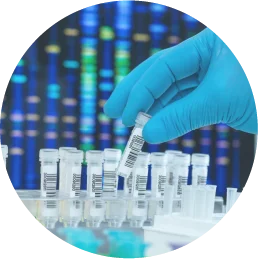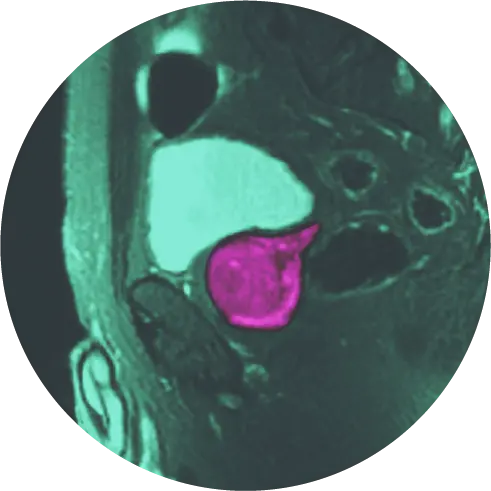Prostate Cancer Diagnosis
Diagnosing Prostate Cancer With Precision
HALO’s MRI-Guided Biopsy
At HALO Diagnostics, we use MRI-guided biopsy to verify if or what type of cancer is present. MRI-guided biopsy is performed under an MRI which allows the team to guide a biopsy needle in real-time and target exactly the area of the prostate that looked suspicious under the screening mpMRI. This approach can ensure a more accurate sampling without damaging healthy prostate tissue compared to more traditional approaches.
Traditional Biopsy Can Miss 30% or More of Cancers
More traditional prostate biopsy procedures, like a transrectal ultrasound (TRUS) guided biopsy, take a “poke and hope” approach – poke the prostate multiple times and hope to hit the right area of the gland. With a TRUS biopsy, cores are taken with much less clear views of the prostate which often can lead to missing tumors at the front of the gland (area most distant from the rectal wall) and under-sampling the area furthest from the bladder. Because of this, a TRUS biopsy can miss 30% or more of cancers, potentially leading to inaccurate diagnoses.
Fusion Biopsy: MRI + Ultrasound
Another frequently performed prostate biopsy is an MRI/Ultrasound Fusion Guided Biopsy. This approach can be more accurate than the traditional TRUS biopsy. To perform a fusion biopsy, a urologist will combine previously obtained MRI images of the prostate with real-time ultrasound imaging (hence the term fusion). While often not as accurate as an MRI-guided biopsy, MRI/Ultrasound Fusion Guided Biopsy is an improvement over the traditional TRUS approach.
MRI-TARGETED BIOPSY WAS SUPERIOR TO STANDARD TRANSRECTAL ULTRASONOGRAPHY-GUIDED BIOPSY IN MEN AT CLINICAL RISK FOR PROSTATE CANCER WHO HAD NOT UNDERGONE BIOPSY PREVIOUSLY.
(Conclusions from the PRECISION trial, NTC02380027)
Advantages of MRI-Guided Biopsy
- Specific targeting of tumor instead of random sampling – TRUS biopsy can miss aggressive lesions more than 30% of the time.
- Minimally invasive with fewer samples taken (3-4) instead of 12 samples with TRUS biopsy.
- Lower risk of pain and damage to the rectal wall.
- Reduced chances of infection.
- Increased sensitivity of detecting aggressive lesions with decreased potential for detecting indolent disease.
- Better detection means a reduction in overtreatment and helps prevent the psychological burden associated with misclassification of cancer stage.
- Better spatial localization with specialized software to reach tumor suspicious regions otherwise difficult to reach with TRUS biopsy.
Personalized Prostate Cancer Care With Genetic Testing
Much like the prostate specific antigen that is used in PSA testing, there are other biomarkers that may help your physician diagnose prostate cancer. HALO Dx works with ExosomeDx™ and is proud to offer the ExoDx Prostate Test, a urine-based test that is used similarly to a PSA test before biopsy. The test analyzes three cancer-specific biomarkers found in the urine that are associated with aggressive prostate cancer. These biomarkers or genes in this case are: ERG, PCA and SPDEF. This simple non-invasive test can help assess your risk of having clinically significant high-grade prostate cancer and help you and your doctor determine whether to proceed with or defer a prostate biopsy.
Along with traditional pathology of the biopsy results, HALO Dx offers genomic tests on the same tissue sample to help identify the appropriate treatment option(s) and help determine the metastatic potential of the tumor through the Decipher® Prostate Cancer Test. We have seen impressive results over the years and have demonstrated that the Decipher test can be used to help predict response to Laser Focal Therapy.
What Is a Gleason Score?
6 or Less
Also called low Grade
The cancer is likely to grown and spread very slowly.
If the cancer is small, many years may pass before it becomes a problem. Thus, you may never need cancer treatment
7
Also called intermediate grade
The cancer is likely to grown and spread very slowly at a modest place.
If the cancer is small several years may pass before it becomes a problem. To prevent problems, treatment may be needed
8,9 or 10
Also called high grade
The cancer is likely to grown and spread fast.
If the cancer is small, few years may pass before it becomes a problem. To prevent problems, treatment may be needed.
What are Grade Groups?
Gleason scores are organized into grade groups. Grade groups are meant to be simpler and more accurate by breaking up Gleason score 7 into two subgroups. This helps prevent over treatment for those with low-grade prostate cancer. Grade Group 2 (Gleason pattern 3+4) means that the cancer cells in the largest area of the cancer are less aggressive than the cancer cells in the second largest area, and Grade Group 3 (Gleason pattern 4+3) means that the cancer cells in the largest area of the cancer are more aggressive than the cancer cells in the second largest area.
1
Gleason score 6 or less
Gleason pattern 1+3, 2+3, 3+3
2
Gleason score 7
Gleason pattern 3+4
3
Gleason score 7
Gleason pattern 4+3
4
Gleason score 8
Gleason pattern 4+4, 3+5, 5+3
5
Gleason score 9 or 10
Gleason pattern 4+5, 5+4, 5+5
Schedule a Call
Submit this form and we will contact you, usually within 24 hours, to answer your Prostate screening, diagnosis, and treatment questions.



